How do you attach an Amphenol FCI "clincher connector" to a thin film force sensitive resistor? I see several sites selling these connectors explicitly for making it easier to wire FSRs, but almost no one explains how to attach them.
I found this single very bad "how to" video, but the video resolution is so low, I can't tell what's going on. They say to "trim off the leads", but it's unclear what that means. Are you supposed to trim off the pins, or the entire metal crimps on the FSR's default connector before applying the clincher connector? In the video, it looks like they just trim off the pins, and not the metal crimps, but I can't tell for sure.
